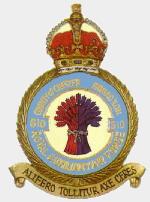Hobby Master HA7801 RAF Supermarine Spitfire Mk. I Fighter - "DW-N", Flight Leftenant John Ellis, No.610 Squadron, RAF Biggin Hill, July 1940 (1:48 Scale)
"Never in the field of human conflict was so much owed by so many to so few."
- British Prime Minister Winston Churchill, commenting on the British airmen in the Battle of Britain
 The Spitfire is the most famous British aircraft of all time. Although less numerous than the Hawker Hurricane, it is remembered as the sleek, thoroughbred fighting machine that turned the tide during the Battle of Britain. The Spitfire was among the fastest and most maneuverable prop-driven fighters of World War II, serving in virtually every combat theater.
The Spitfire is the most famous British aircraft of all time. Although less numerous than the Hawker Hurricane, it is remembered as the sleek, thoroughbred fighting machine that turned the tide during the Battle of Britain. The Spitfire was among the fastest and most maneuverable prop-driven fighters of World War II, serving in virtually every combat theater.
Supermarine designer Reginald Mitchell created this small, graceful, elliptical-wing fighter with eight guns in the wings that were able to fire without being hindered by the propeller. The immortal Spitfire thus became not merely one of the best-performing fighters of all time, but also one of the best-looking. Although never employed as a long-range escort, the Spitfire was a champion in an air-to-air duel. Spitfires routinely dived at the speed of sound, faster than any of the German jets.
A carrier-based version, called the Seafire, was a winner in its own right, serving valiantly on convoy routes during World War II. The Seafire 47 was even used in the early stages of the Korean War, before it was replaced by more modern jet aircraft.
Pictured here is a 1:48 scale replica of a Supermarine Spitfire Mk. I fighter that was piloted by Flight Leftenant John Ellis, who was attached to No.610 Squadron, then deployed to RAF Biggin Hill, during July 1940.
Sold Out!
Dimensions:
Wingspan: 9-inches
Length: 7-1/2-inches
Release Date: August 2010
 Historical Account: "The Valorous" - No. 610 Squadron was attached to No.13 Group during the Battle of Britain. It had initially been based at RAF Gravesend, but moved to RAF Biggin Hill before the German offensive began and was one of the units bearing the brunt of German attacks. It moved to RAF Acklington for rest and recuperation at the end of August, having sustained severe casualties. During the Battle of Britain the squadron included Pilot Officer, later Squadron Leader, Constantine Pegge.
Historical Account: "The Valorous" - No. 610 Squadron was attached to No.13 Group during the Battle of Britain. It had initially been based at RAF Gravesend, but moved to RAF Biggin Hill before the German offensive began and was one of the units bearing the brunt of German attacks. It moved to RAF Acklington for rest and recuperation at the end of August, having sustained severe casualties. During the Battle of Britain the squadron included Pilot Officer, later Squadron Leader, Constantine Pegge.
In 1941, the squadron moved south to RAF Tangmere where it was one of Douglas Bader's three Spitfire squadrons of the Tangmere wing. No.610 Squadron remained based in the UK until 1945, when it moved to the continent to provide fighter cover as the allies entered Germany. No. 610 Squadron was disbanded before the end of the war at RAF Warmwell on March 3rd, 1945.








